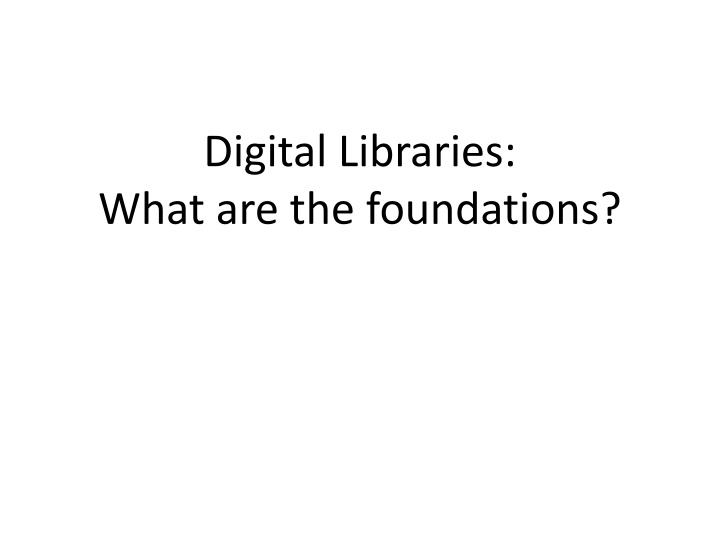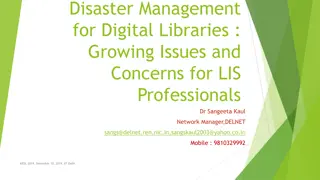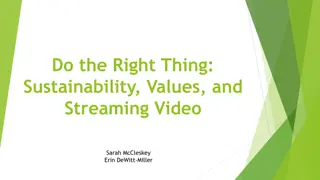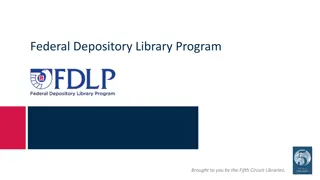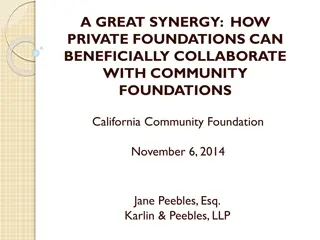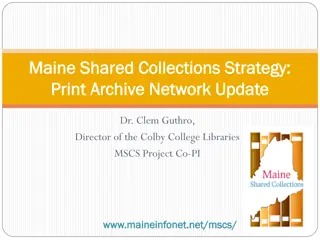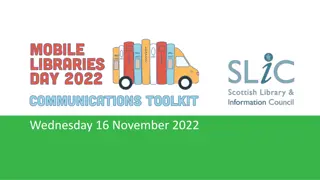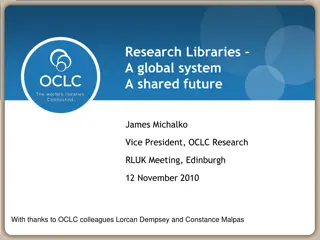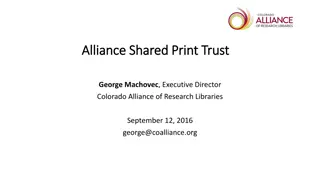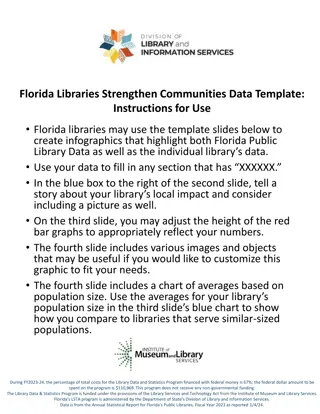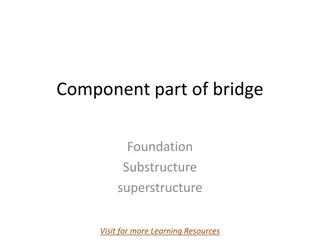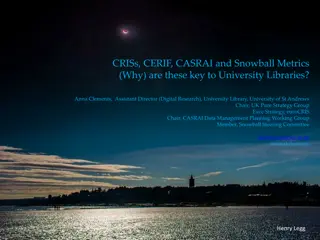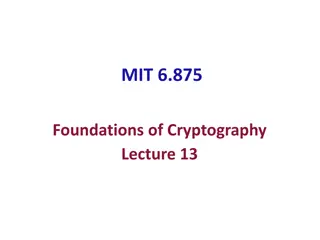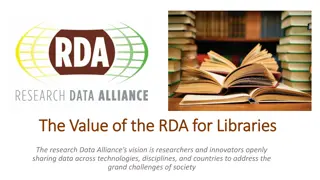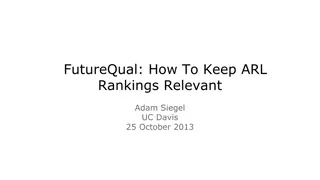Overview of Digital Libraries and Their Foundations
Digital libraries are networked collections of digital objects that enhance knowledge building processes by addressing information overload, communication barriers, and research inefficiencies. Solutions include innovative technologies like mini-cameras, OCR, and natural language processing. Various definitions highlight the importance of structure, access, and preservation in digital libraries.
Download Presentation

Please find below an Image/Link to download the presentation.
The content on the website is provided AS IS for your information and personal use only. It may not be sold, licensed, or shared on other websites without obtaining consent from the author.If you encounter any issues during the download, it is possible that the publisher has removed the file from their server.
You are allowed to download the files provided on this website for personal or commercial use, subject to the condition that they are used lawfully. All files are the property of their respective owners.
The content on the website is provided AS IS for your information and personal use only. It may not be sold, licensed, or shared on other websites without obtaining consent from the author.
E N D
Presentation Transcript
Digital Libraries: What are the foundations?
Vannevar Bush Some day there will be an easy way to store, disseminate, and preserve all of man s knowledge, without leaving your desk.
Knowledge Building Process Problems Too much information Scientists can t communicate across disciplines Over specialization, no longer can be generalist Research slowing because the amount of time required to know the literature Knowledge dissemination too slow Too much repetitive activities, reading, analysis etc.
Solutions Mini-camera fit on head, size of walnut Google maps (what are some others?) Dry photography ? Compression is a key term Computers that are Mind like How can we do math with letters? OCR, Natural Language Processing, Text Mining, Speech recognition ( a la Apple s Siri)
Another DL Definition A digital library is a networked collection of digital objects text, still images, moving images, sound, data with arrangement, search features, and metadata that allow for discovery and presentation, supporting research and teaching, and with attention paid to architecture, persistence, longevity, and digital preservation. (Jenn Riley, IU)
Another DL Definition A digital library is a special library with a focused collection of digital objects that can include text, visual material, audio material, video material, stored as electronic media formats (as opposed to print, microform, or other media), along with means for organizing, storing, and retrieving the files and media contained in the library collection. Digital libraries can vary immensely in size and scope, and can be maintained by individuals, organizations, or affiliated with established physical library buildings or institutions, or with academic institutions.[1] (Wikipedia)
Another DL Definition Digital libraries are organizations that provide the resources, including the specialized staff, to select, structure, offer intellectual access to, interpret, distribute, preserve the integrity of, and ensure the persistence over time of collections of digital works so that they are readily and economically available for use by a defined community or set of communities. (Don Waters, DLF)
Collections of Digital Works "Collections of digital works...." Distinctions among libraries commonly focus on the subject matter that defines the collections (e.g., medical, art, science, music, and such), or on the communities interested in the collected materials (e.g., research, college, public).
Aspects of a Collection Is built following a collection policy Is described so a user can discover its characteristics Contains actively managed resources Respects intellectual property rights Is interoperable Integrates into the user s workflow Is sustainable
Types of Digital Libraries Stand-alone Digital Library (SDL) also self-contained, several collections Federated Digital Library (FDL) also confederated, networked Harvested Digital Library (HDL) also distributed
Standalone DL A typical Digital Library Usually installed on a web server Self-contained material: born digital scanned or digitized purchased or licensed Single or Several digital collections
Federated DL Contains many separate digital libraries Usually heterogeneous repositories Uses search layer federated search Connected via a network Forms a virtual library Unified/Transparent user interface The major problem is interoperability (does the metadata cross walk properly? Does it render well? Example: Brown University Digital Repository
Harvested DL Harvests digital objects, not full DLs. Objects harvested into metadata (using Open Archives Initiative). Does not have to contain objects, just metadata/summaries. But has regular DL characteristics They contain the summaries about the objects, and typically direct you to the home DL if you want to see/hear digital object Example: Digital Public Library of America
Breakdown Single Digital Library Harvested Digital Library & Federated Items Origin Purchased/Digitized Gathered Items Location Local/Networked Scattered Material Items+Catalog Catalog Repository Size Large Small Update Medium Fast/Dynamic Composition Method Interoperability Inherent Examples: College or University DL Digital Public Library of America (DPLA)
Acquiring: Digital Collections The digital acquisition continuum: mirroring hosting archiving linking LESS MORE Amount of Responsibility New procedures and workflows are required tape loading, scanning, format conversion, etc.
Staffing Every DL will require staff Some designated titles, some part time or cross trained Grant funded Cataloger, metadata specialist Digital curator Systems Librarian Maybe one designated unit or a blend of staff across departments.
Types of Materials Library/archives flavored items Audio, video, books, images, documents Scientific materials Datasets, raw image data, GIS, Architecture etc. raw materials that would have never gone on a book shelf Gene banks, phonology (speech)
Born Digital Born-digital resources are items created and managed in digital form. Types: Images, Audio, Documents, Video, data-centric materials, websites electronic records Data or information that has been captured and fixed for storage and manipulation in an automated system and that requires the use of the system to render it intelligible by a person.
Digitization Digitization is the process of converting information into a digital format. In this format, information is organized into discrete units of data (called bit s) that can be separately addressed (usually in multiple-bit groups called bytes). Digitize: The process of transforming analog material into binary electronic (digital) form, especially for storage and use in a computer. (SAA)
Acquiring: Image File Formats Archival version: high-resolution TIFF Online versions: Preview: low-resolution GIF Full: medium-resolution JPEG High: med./high-resolution JPEG or TIFF Up-and-coming: MrSID, Flashpix, PNG Formats Lossy and lossless .jpg, .tiff, .raw
Scanners Flatbed Scanner Cheap and relatively easy to operate. High resolution, but slow Overhead Camera Fragile items More difficult Lighting
Digital Images Digital Images are electronic snapshots taken of a scene or scanned from documents, such as photographs, manuscripts, printed texts, and artwork. The digital image is sampled and mapped as a grid of dots or picture elements (pixels). Each pixel is assigned a tonal value (black, white, shades of gray or color), which is represented in binary code (zeros and ones). The binary digits ("bits") for each pixel are stored in a sequence by a computer and often reduced to a mathematical representation (compressed). The bits are then interpreted and read by the computer to produce an analog version for display or printing.
Digital Image Pixel: Is the smallest controllable element on a screen Image Resolution: How many pixels per-square inch Bit Depth: is determined by the number of bits used to define each pixel. The greater the bit depth, the greater the number of tones (grayscale or color) that can be represented. Digital images may be produced in black and white (bitonal), grayscale (8 bit), or color (24 bit). Pixel Values: As shown in this bitonal image, each pixel is assigned a tonal value, in this example 0 for black and 1 for white.
